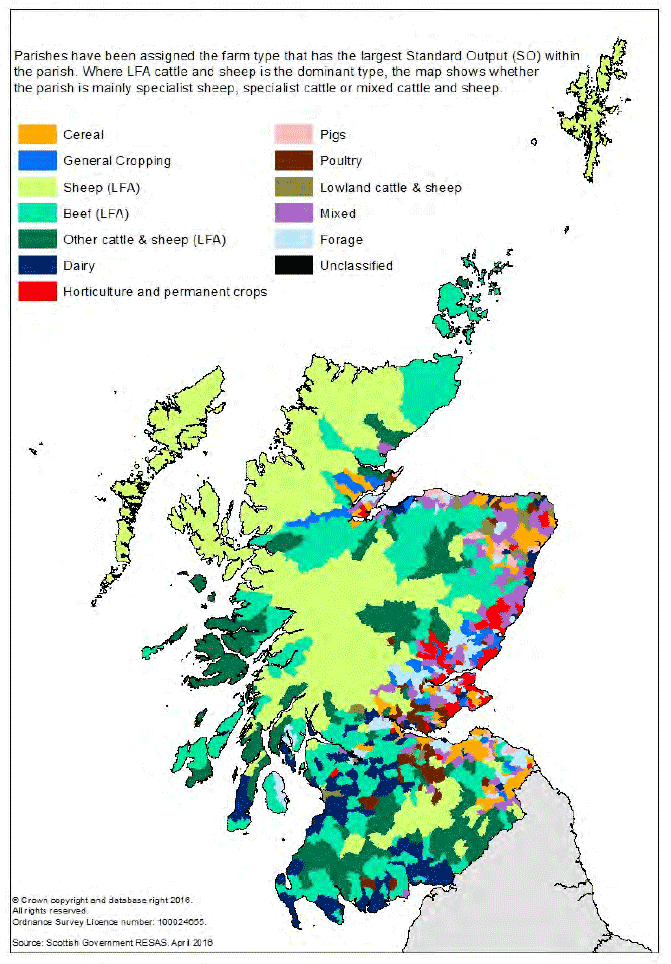Economic Report on Scottish Agriculture, 2016
Presents an overall picture of Scottish agriculture using data from the various agricultural surveys that RESAS manage.
This document is part of a collection
2.5 Standard Outputs and farm types (Maps 5 and 6 and tables C1 and C23)
Standard Outputs ( SO) represent the notional farm-gate worth generated by a holding's crops and livestock and is calculated by applying multipliers (in £s) to all crop areas and livestock units. These multipliers are applied uniformly across Scotland. The multipliers used in this publication are based on a five year average, centred around the year 2010, and these have been applied to the 2015 crop areas and livestock units of holdings. This contrasts with those produced in 2014 which were based on 2007-centred coefficients, which results in a step change in the data between these two years. Further information on these changes, including an adjusted annual comparison, is available in section 4.12 of the publication, 'Results from the June 2015 Scottish Agricultural Census' [2] .
Using results from the June Agricultural Census, holdings are then classified into farm types, which are allocated generally if the contribution of a specific farming activity accounts for at least two-thirds of a holding's total SO value.
There are eleven basic farm types (cereals, general cropping, horticulture & permanent crops, specialist pigs, specialist poultry, dairy, cattle & sheep ( LFA), lowland cattle & sheep, mixed, forage, and other). 'Other' relates to holdings with no SO value ( e.g. holdings with fallow land only), whereas 'mixed' is where no single crop or livestock category accounts for two-thirds of the holding's SO value. However the same calculation can be used to subdivide the categories further, and so this publication also includes analysis (in the Farm Accounts Survey results and in Map 5) of cattle & sheep ( LFA) farms split into three categories; specialist cattle ( LFA), specialist sheep ( LFA), and other cattle & sheep ( LFA). Please do not confuse the latter with the overall cattle & sheep ( LFA) category.
This SO methodology is implemented in line with EC requirements and was first used in the June 2013 Agricultural Census. More information on the change to SOs and the new typology can be found in the Economic Report for Scottish Agriculture, 2013 Edition [3] .
The geographic distribution of these farm types is presented in Map 5. It should be noted that this map shows a generalised view by parish rather than by holding, with a parish being allocated the farm type of whichever farm type SO total within the parish is the largest. The map also uses the split of cattle & sheep ( LFA) into the three sub-categories, as described above.
While Map 5 shows what the most common type of activity is in a given area, it should not be taken to illustrate where activities most commonly take place. It may correctly imply that cereal farming is generally in the east, but it would be wrong to infer that cattle and sheep are more prevalent in the Highlands. Maps 10 and 11 show that both cattle and sheep are more generally found south of the central belt and in Grampian - cattle and sheep only dominate in the north-west because there is comparatively little other farming activity there.
Table C23 presents information on each of the main farm types in Scotland, showing the total number of holdings, total agricultural area and total size in terms of SOs (Standard Outputs) and SLRs (Standard Labour Requirements, see section 7.3). The most common farm type was 'general cropping; forage' which totalled 22,306 holdings. This was followed by cattle & sheep ( LFA) (14,546 holdings) and mixed holdings (5,322). Lowland cattle & sheep and cereal farms were fairly prevalent (with around 2,500 holdings each). General cropping and poultry farms numbered around 1,000 each, while horticulture and pig holdings were the least common farm types.
Map 5: Farm type by agricultural parish, 2015

Contact
There is a problem
Thanks for your feedback